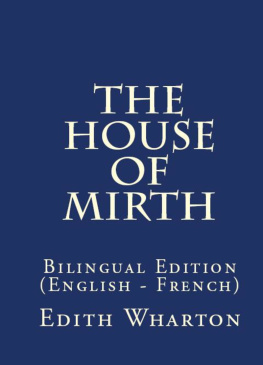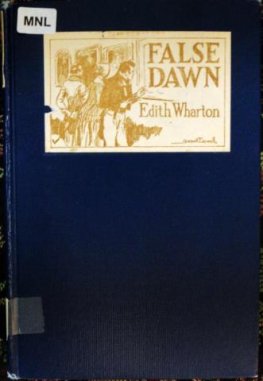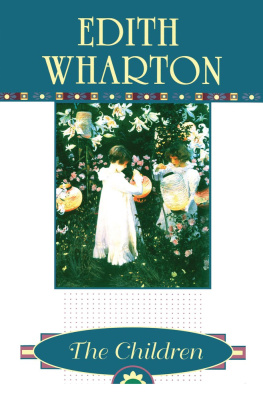Edith Wharton

Edith Wharton

DOVER PUBLICATIONS, INC.
Mineola, New York
DOVER THRIFT EDITIONS
G ENERAL E DITOR : M ARY C AROLYN W ALDREP E DITOR O F T HIS V OLUME : J IM M ILLER
Copyright
Copyright 2015 by Dover Publications, Inc.
All rights reserved.
Bibliographical Note
Edith Wharton: The Dover Reader, first published by Dover Publications, Inc., in 2015, is a new compilation of works by Edith Wharton, reprinted from authoritative sources. In the excerpts from The Decoration of Houses, the Introduction has been slightly abridged and the illustrated plates have been omitted from the five subsequent chapters. In addition, all references to the plates have been removed from the text. The Note has been specially prepared for this Dover edition.
International Standard Book Number
eISBN-13: 978-0-486-79121-0
Manufactured in the United States by Courier Corporation
79121101 2015
www.doverpublications.com
Note
E DITH N EWBOLD J ONES . was born on January 24th, 1862 into one of New Yorks wealthiest families. Educated by governesses on both sides of the Atlantic and self-taught in her fathers library, she began writing poems and stories as a child, attempting her first novel at age eleven. When Edith was sixteen her mother had some of her verses privately printed, and later, on the recommendation of Henry Wadsworth Longfellow, had one of them accepted by William Dean Howells for The Atlantic Monthly. Socially she followed the course of a debutante, and in 1885 married Edward Teddy Wharton and took her place in the high society of New York, Boston, and Newport. The childless marriage was not a happy one as Teddy Wharton was inclined to idleness and was not particularly interested in his wifes literary ambitions. The marriage was maintained until 1913 when Edith divorced Teddy on the grounds of his infidelity.
What Wharton herself called the slow stammering beginnings of her career did not take hold until 1888 when she began to write and publish seriously. In 1905 she began the period of her most important work with the publication of The House of Mirth. By the time The Age of Innocence was awarded the Pulitzer Prize in 1921, Edith Wharton was among the most renowned novelists in the world. She would continue to write until her death at her long-time home in France on August 11th, 1937, at age seventy-five.
The purpose of this anthology is to showcase the wide spectrum of Edith Whartons literary career. We have therefore included excerpts from her 1897 nonfiction work The Decoration of Houses (co-written with Ogden Codman, Jr.) as well as short stories, poems, and, arguably, her two greatest novels, Ethan Frome and The Age of Innocence.
Contents
Edith Wharton
NONFICTION
THE DECORATION OF HOUSES
INTRODUCTION
R OOMS MAY be decorated in two ways: by a superficial application of ornament totally independent of structure, or by means of those architectural features which are part of the organism of every house, inside as well as out.
In the middle ages, when warfare and brigandage shaped the conditions of life, and men camped in their castles much as they did in their tents, it was natural that decorations should be portable, and that the naked walls of the medival chamber should be hung with arras, while a ciel, or ceiling, of cloth stretched across the open timbers of its roof.
When life became more secure, and when the Italian conquests of the Valois had acquainted men north of the Alps with the spirit of classic tradition, proportion and the relation of voids to masses gradually came to be regarded as the chief decorative values of the interior. Portable hangings were in consequence replaced by architectural ornament: in other words, the architecture of the room became its decoration.
This architectural treatment held its own through every change of taste until the second quarter of the present century; but since then various influences have combined to sever the natural connection between the outside of the modern house and its interior. In the average house the architects task seems virtually confined to the elevations and floor-plan. The designing of what are today regarded as insignificant details, such as mouldings, architraves, and cornices, has become a perfunctory work, hurried over and unregarded; and when this work is done, the upholsterer is called in to decorate and furnish the rooms.
As the result of this division of labor, house-decoration has ceased to be a branch of architecture. The upholsterer cannot be expected to have the preliminary training necessary for architectural work, and it is inevitable that in his hands form should be sacrificed to color and composition to detail. In his ignorance of the legitimate means of producing certain effects, he is driven to all manner of expedients, the result of which is a piling up of heterogeneous ornament, a multiplication of incongruous effects; and lacking, as he does, a definite first conception, his work becomes so involved that it seems impossible for him to make an end.
The confusion resulting from these unscientific methods has reflected itself in the lay mind, and house-decoration has come to be regarded as a black art by those who have seen their rooms subjected to the manipulations of the modern upholsterer. Now, in the hands of decorators who understand the fundamental principles of their art, the surest effects are produced, not at the expense of simplicity and common sense, but by observing the requirements of both. These requirements are identical with those regulating domestic architecture, the chief end in both cases being the suitable accommodation of the inmates of the house.
The fact that this end has in a measure been lost sight of is perhaps sufficient warrant for the publication of this elementary sketch. No study of house-decoration as a branch of architecture has for at least fifty years been published in England or America; and though France is always producing admirable monographs on isolated branches of this subject, there is no modern French work corresponding with such comprehensive manuals as dAvilers Cours dArchitecture or Isaac Wares Complete Body of Architecture.
The attempt to remedy this deficiency in some slight degree has made it necessary to dwell at length upon the strictly architectural principles which controlled the work of the old decorators. The effects that they aimed at having been based mainly on the due adjustment of parts, it has been impossible to explain their methods without assuming their standpointthat of architectural proportion in contradistinction to the modern view of house-decoration as superficial application of ornament. When house-decoration was a part of architecture all its values were founded on structural modifications; consequently it may seem that ideas to be derived from a study of such methods suggest changes too radical for those who are not building, but are merely decorating. Such changes, in fact, lie rather in the direction of alteration than of adornment; but it must be remembered that the results attained will be of greater decorative value than were an equal expenditure devoted to surface-ornament. Moreover, the great decorators, if scrupulous in the observance of architectural principles, were ever governed, in the use of ornamental detail, by the , the wise moderation, of the Greeks; and the rooms of the past were both simpler in treatment and freer from mere embellishments than those of to-day.











